Classification of the Circulation Patterns Related to Strong Dust Weather in China Using a Combination of the Lamb–Jenkinson and k-Means Clustering Methods
Abstract
:1. Introduction
2. Data and Methods
2.1. Meteorological Data
2.2. Reanalysis Data
2.3. Objective Circulation Classification
2.3.1. Lamb–Jenkinson Scheme
2.3.2. k-Means
3. Results
3.1. Results of Lamb–Jenkinson Scheme
3.1.1. Surface Circulation Types in the Three Main Areas Influenced by Dust
3.1.2. Annual Variation of the Dominant Circulation Pattern in the Area Influenced by Dust
3.2. Results of k-Means Method
3.2.1. Dominant Circulation Patterns and Their Characteristics
3.2.2. Variation of the Dominant Circulation Pattern over Time
3.3. Results of Dominant SDS Circulation Patterns in 2021
4. Conclusions
- The Lamb–Jenkinson scheme was used to classify the circulation patterns in the southern Xinjiang basin, western Inner Mongolia and southern Mongolia, and the center of Inner Mongolia. The results showed that the main circulation patterns in the southern Xinjiang basin were the W, A, C, SW, and CW types, whereas the circulation patterns favoring SDSs were the SW, A, and C types. The main circulation patterns in western Inner Mongolia and southern Mongolia were the N, NW, E, A, and C types. The circulation patterns in these regions that favored SDSs were the NW, N, A, and C types. The main circulation patterns in Inner Mongolia were the SW, W, NW, A, and C types, and the circulation patterns that favored SDSs were the SW, N, SW, and A types.
- The k-means clustering method was used to calculate the spring SLP, 10 m wind, and height, wind and, temperature fields at 500 hPa from 2000 to 2020 to determine nine types of circulation patterns. The T1, T2, T3, T5, and T8 patterns were the dominant circulation types with occurrence probabilities of 17.50, 16.27, 26.04, 20.41, and 31.37%. Analysis of the five circulation types showed that the influencing system of the T1 circulation pattern was an area of cold high pressure and a cold front at ground level; the main propagation path of SDSs was westerly and northwesterly. The main influencing system for the T2 circulation pattern was the Mongolian cyclone, and the main propagation path of this type of SDS was northwesterly. The main influencing system of the T3 circulation type was the Mongolian cyclone and cold front, and the main propagation path was westerly and northwesterly. The main influencing system for the T5 circulation pattern was the ground-level thermal low-pressure region and cold front, and the main propagation path was westerly and northwesterly. The main influencing system for the T8 circulation pattern was the cold front, and the main propagation path of this type of dusty weather was northwesterly.
- Based on the analysis of the variation of the number of days of SDS in spring in China, with time for the five dominant circulation patterns, we found that the occurrence of SDSs influenced by the dominant circulation pattern was more frequent from 2000 to 2010. From 2000 to 2005, the occurrence frequency of SDSs was the highest for the T8 circulation pattern—that is, China was mainly affected by the cold front circulation type, which mainly spread along a northwesterly path. This kind of dust weather usually has a high intensity, wide area of impact, rapid propagation speed, and leads to disastrous weather events. From 2006 to 2010, the T3 and T8 circulation types dominated and were mainly influenced by the Mongolian cyclone and cold front. SDSs mainly spread along a west-northwesterly path, so dust weather was more frequent in this period. From 2011 to 2015, the T1 circulation pattern was dominant and was mainly affected by a cold high-pressure region. The main propagation path was west-northwest, and the occurrence frequency of SDSs decreased overall. From 2016 to 2020, the T3 circulation type dominated and was mainly influenced by the Mongolian cyclone and cold front. Dust mainly spread along a westward path, and the number of SDSs increased compared with the period from 2011 to 2015.
- The main circulation patterns of four SDS processes in 2021 were analyzed using a combination of the Lamb–Jenkinson and k-means methods. The SDS events in 2021 were closest to the T3 circulation pattern and were mainly influenced by both the Mongolian cyclone and the surface cold front. The main propagation path was westerly and northwesterly. The SDSs originated in Mongolia and were guided by westerly and northwesterly air flows. The main body of dust moved to the east, affecting northwest and north China, and the west and south of northeast China.
Author Contributions
Funding
Institutional Review Board Statement
Informed Consent Statement
Data Availability Statement
Acknowledgments
Conflicts of Interest
References
- Goudie, A.S.; Middleton, N.J. The changing frequency of dust storms through time. Clim. Chang. 1992, 20, 197–225. [Google Scholar] [CrossRef]
- Tegen, I.; Fung, I. Modeling of mineral dust in the atmosphere: Sources, transport, and optical thickness. J. Geophys. Res. 1994, 99, 22897–22914. [Google Scholar] [CrossRef]
- Zender, C.S.; Miller, R.L.; Tegen, I. Quantifying mineral dust mass budgets: Terminology, constraints, and current estimates. Eos Trans. Am. Geophys. Union 2004, 85, 509–512. [Google Scholar] [CrossRef]
- Ge, Y.; Abuduwaili, J.; Ma, L.; Wu, N.; Liu, D. Potential transport pathways of dust emanating from the playa of Ebinur Lake, Xinjiang, In arid northwest China. Atmos. Res. 2016, 178–179, 196–206. [Google Scholar] [CrossRef]
- Lee, E.H.; Sohn, B.J. Recent increasing trend in dust frequency over Mongolia and Inner Mongolia regions and its association with climate and surface condition change. Atmos. Environ. 2011, 45, 4611–4616. [Google Scholar] [CrossRef]
- Chen, S.; Huang, J.; Kang, L.; Wang, H.; Ma, X.; He, Y.; Yuan, T.; Yang, B.; Huang, Z.; Zhang, G. Emission, transport, and radiative effects of mineral dust from the Taklimakan and Gobi deserts: Comparison of measurements and model results. Atmos. Chem. Phys. 2017, 17, 2401–2421. [Google Scholar] [CrossRef] [Green Version]
- Zhang, X.Y.; Arimoto, R.; An, Z.S. Dust emission from Chinese desert sources linked to variations in atmospheric circulation. J. Geophys. Res. Atmos. 1997, 102, 28041–28047. [Google Scholar] [CrossRef]
- Yassin, M.F.; Almutairi, S.K.; Al-Hemoud, A. Dust storms backward Trajectories’ and source identification over Kuwait. Atmos. Res. 2018, 212, 158–171. [Google Scholar] [CrossRef]
- Al-Hemoud, A.; Al-Sudairawi, M.; Neelamanai, S.; Naseeb, A.; Behbehani, W. Socioeconomic effect of dust storms in Kuwait. Arab. J. Geosci. 2017, 10, 18. [Google Scholar] [CrossRef]
- Swap, R.; Garstang, M.; Greco, S.; Talbot, R.; Kållberg, P. Saharan dust in the Amazon Basin. Tellus B 1992, 44, 133–149. [Google Scholar] [CrossRef] [Green Version]
- Qian, W.; Tang, X.; Quan, L. Regional characteristics of dust storms in China. Atmos. Environ. 2004, 38, 4895–4907. [Google Scholar] [CrossRef]
- Qian, W.; Quan, L.; Shi, S. Variations of the dust storm in China and its climatic control. J. Clim. 2002, 15, 1216–1229. [Google Scholar] [CrossRef]
- Zhao, C.; Dabu, X.; Li, Y. Relationship between climatic factors and dust storm frequency in Inner Mongolia of China. Geophys. Res. Lett. 2004, 31, 10–12. [Google Scholar] [CrossRef]
- Yang, B.; Bräuning, A.; Zhang, Z.; Dong, Z.; Esper, J. Dust storm frequency and its relation to climate changes in Northern China during the past 1000 years. Atmos. Environ. 2007, 41, 9288–9299. [Google Scholar] [CrossRef]
- Uematsu, M.; Duce, R.A.; Prospero, J.M.; Chen, L.; Merrill, J.T.; McDonald, R.L. Transport of mineral aerosol from Asia over the North Pacific ocean. J. Geophys. Res. 1983, 88, 5343–5352. [Google Scholar] [CrossRef]
- Murayama, T.; Sugimoto, N.; Uno, I.; Kinoshita, K.; Aoki, K.; Hagiwara, N.; Liu, Z.; Matsui, I.; Sakai, T.; Shibata, T.; et al. Ground-based network observation of Asian dust events of April 1998 in east Asia. J. Geophys. Res. Atmos. 2001, 106, 18345–18359. [Google Scholar] [CrossRef] [Green Version]
- Brazel, A.J.; Nickling, W.G. The relationship of weather types to dust storm generation in Arizona (1965–1980). J. Climatol. 1986, 6, 255–275. [Google Scholar] [CrossRef]
- Pauley, P.M.; Baker, N.L.; Barker, E.H. An Observational Study of the “Interstate 5” Dust Storm Case. Bull. Am. Meteorol. Soc. 1996, 77, 693–720. [Google Scholar] [CrossRef]
- Jones, P.D.; Hulme, M.; Briffa, K.R. A comparison of Lamb circulation types with an objective classification scheme. Int. J. Climatol. 1993, 13, 655–663. [Google Scholar] [CrossRef]
- Lamb, H.H. Types and spells of weather around the year in the British Isles: Annual trends, seasonal structure of the year, singularities. Q. J. R. Meteorol. Soc. 1950, 76, 393–429. [Google Scholar] [CrossRef]
- Huang, M.; Gao, Z.; Miao, S.; Xu, X. Characteristics of sea breezes over the Jiangsu coastal area, China. Int. J. Climatol. 2016, 36, 3908–3916. [Google Scholar] [CrossRef]
- Liu, Y.; He, J.; Lai, X.; Zhang, C.; Zhang, L.; Gong, S.; Che, H. Influence of atmospheric circulation on aerosol and its optical characteristics in the pearl river delta region. Atmosphere 2020, 11, 288. [Google Scholar] [CrossRef] [Green Version]
- Chen, D. A monthly circulation climatology for Sweden and its application to a winter temperature case study. Int. J. Climatol. 2000, 20, 1067–1076. [Google Scholar] [CrossRef]
- Liao, W.; Wu, L.; Zhou, S.; Wang, X.; Chen, D. Impact of Synoptic Weather Types on Ground-Level Ozone Concentrations in Guangzhou, China. Asia-Pacific J. Atmos. Sci. 2021, 57, 169–180. [Google Scholar] [CrossRef]
- Brisson, E.; Demuzere, M.; Kwakernaak, B.; Van Lipzig, N.P.M. Relations between atmospheric circulation and precipitation in Belgium. Meteorol. Atmos. Phys. 2011, 111, 27–39. [Google Scholar] [CrossRef]
- China Meteorological Administration (CMA). Classification of Sand and Dust Storm Weather. (GB/T 20480–2017). 2017. Available online: http://www.cmastd.cn/standardView.jspx?id=2378 (accessed on 15 November 2021). (In Chinese).
- Wang, Y.; Stein, A.F.; Draxler, R.R.; de la Rosa, J.D.; Zhang, X. Global sand and dust storms in 2008: Observation and HYSPLIT model verification. Atmos. Environ. 2011, 45, 6368–6381. [Google Scholar] [CrossRef]
- Muñoz-Sabater, J.; Dutra, E.; Agustí-Panareda, A.; Albergel, C.; Arduini, G.; Balsamo, G.; Boussetta, S.; Choulga, M.; Harrigan, S.; Hersbach, H.; et al. ERA5-Land: A state-of-the-art global reanalysis dataset for land applications. Earth Syst. Sci. Data 2021, 13, 4349–4383. [Google Scholar] [CrossRef]
- Xie, Y.; Zhi, X. Impact of COVID-19 Lockdown and Atmospheric Circulation on the Air Quality in Wuhan During Early 2020. E3S Web Conf. 2021, 299, 02011. [Google Scholar] [CrossRef]
- He, J.; Gong, S.; Zhou, C.; Lu, S.; Wu, L.; Chen, Y.; Yu, Y.; Zhao, S.; Yu, L.; Yin, C. Analyses of winter circulation types and their impacts on haze pollution in Beijing. Atmos. Environ. 2018, 192, 94–103. [Google Scholar] [CrossRef] [Green Version]
- Tian, W.; Zheng, Y.; Yang, R.; Ji, S.; Wang, J. A Survey on Clustering based Meteorological Data Mining. Int. J. Grid Distrib. Comput. 2014, 7, 229–240. [Google Scholar] [CrossRef]
- Arroyo, Á.; Herrero, Á.; Tricio, V.; Corchado, E. Analysis of meteorological conditions in Spain by means of clustering techniques. J. Appl. Log. 2017, 24, 76–89. [Google Scholar] [CrossRef]
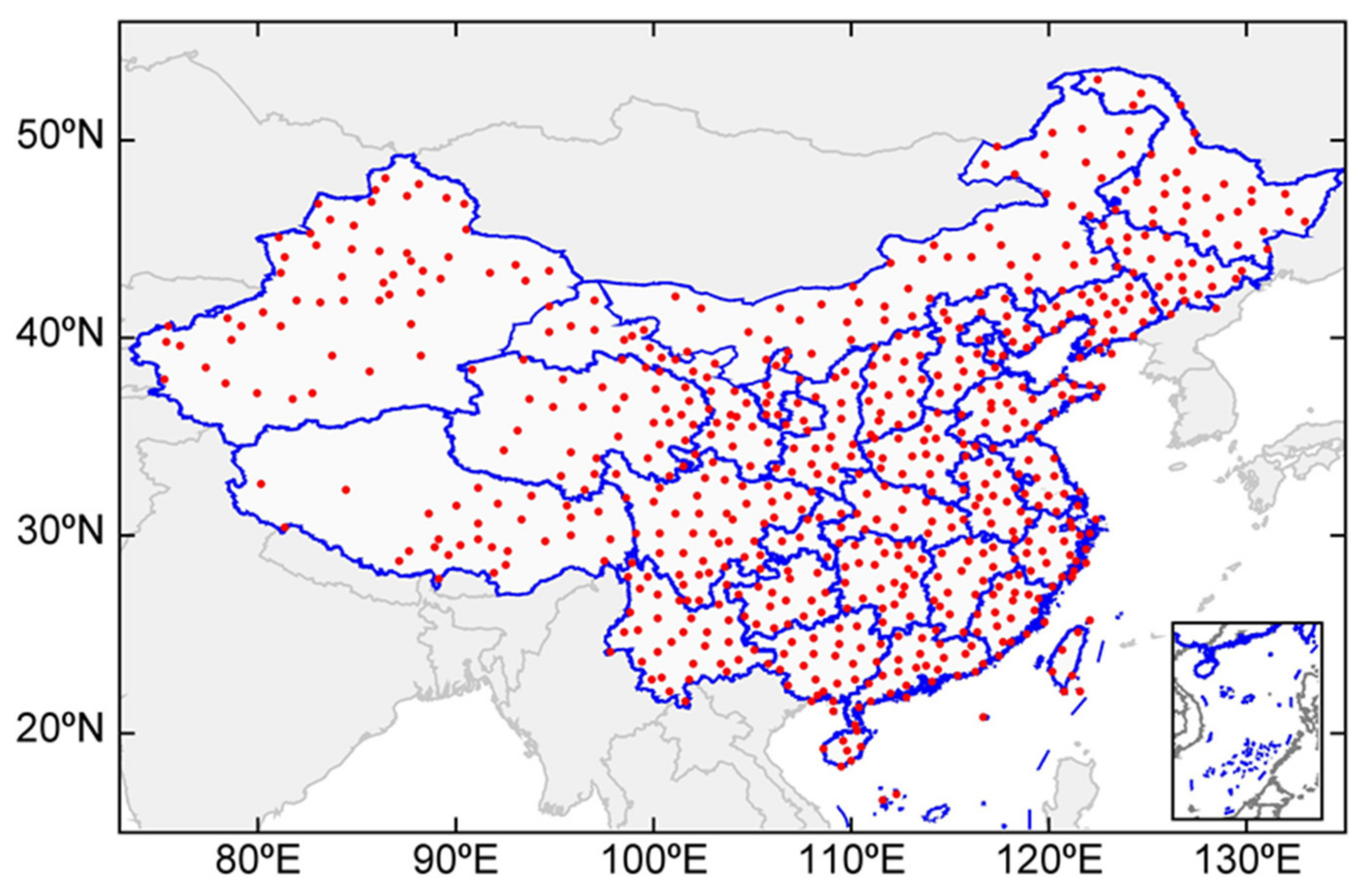
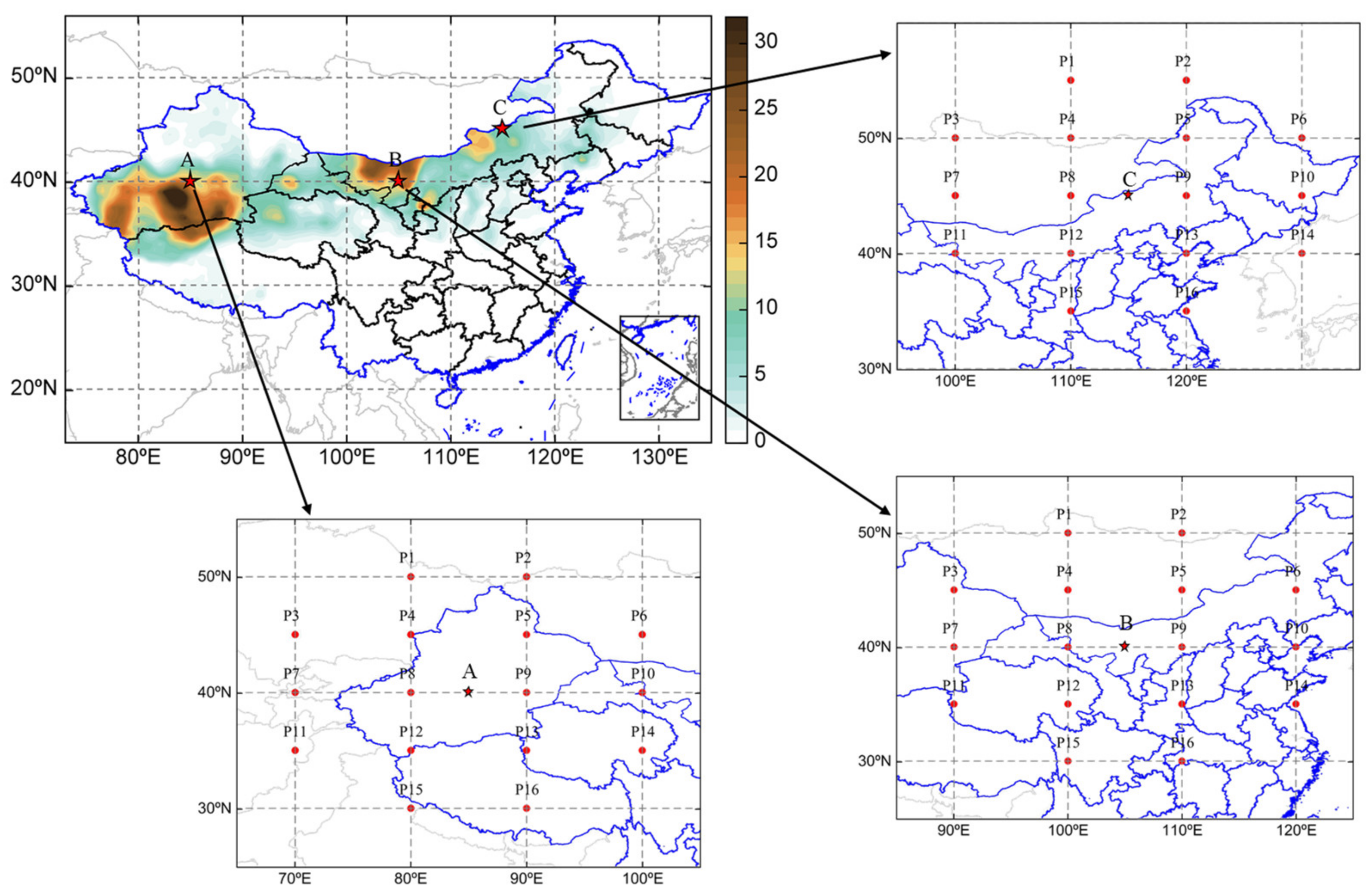


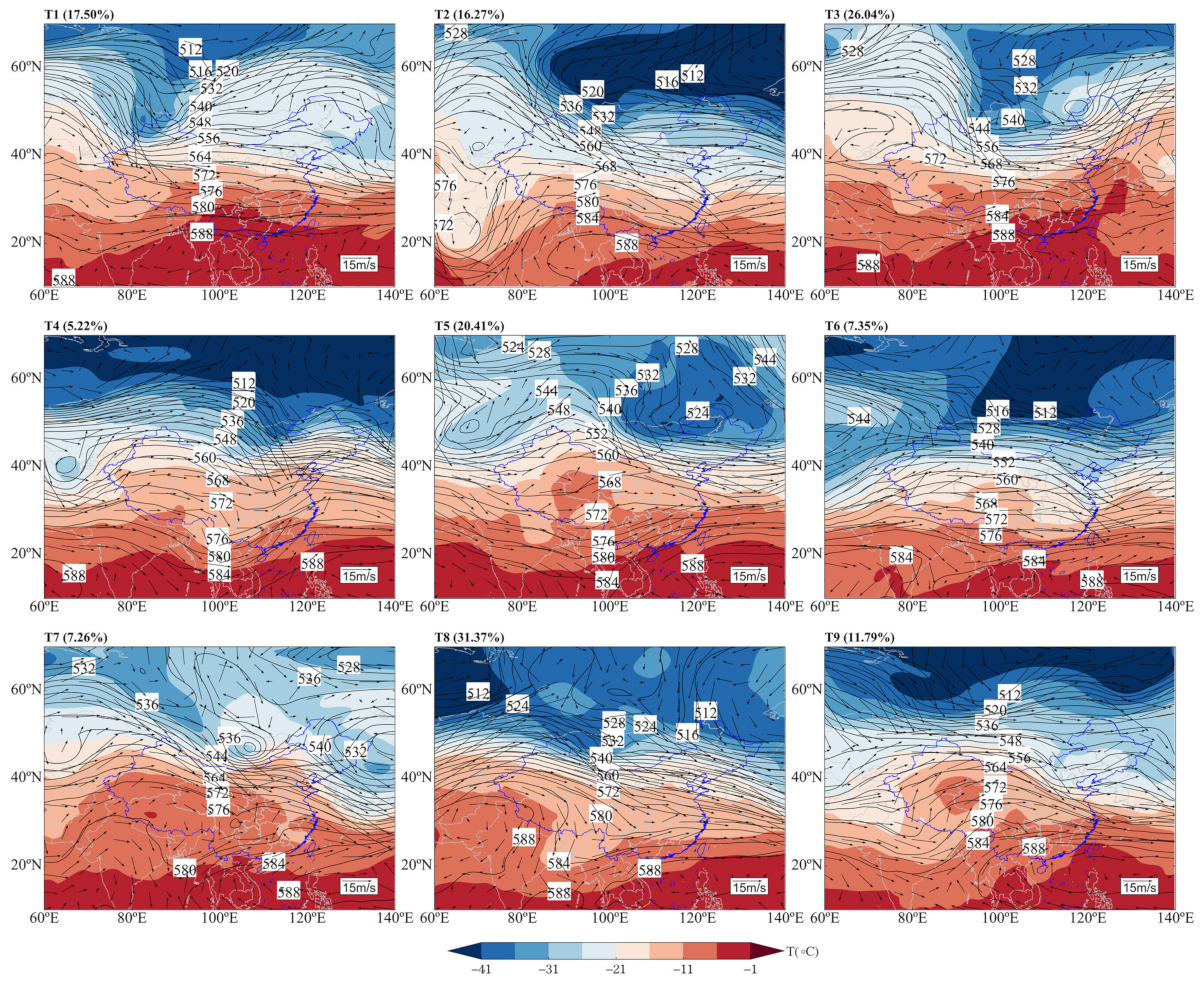
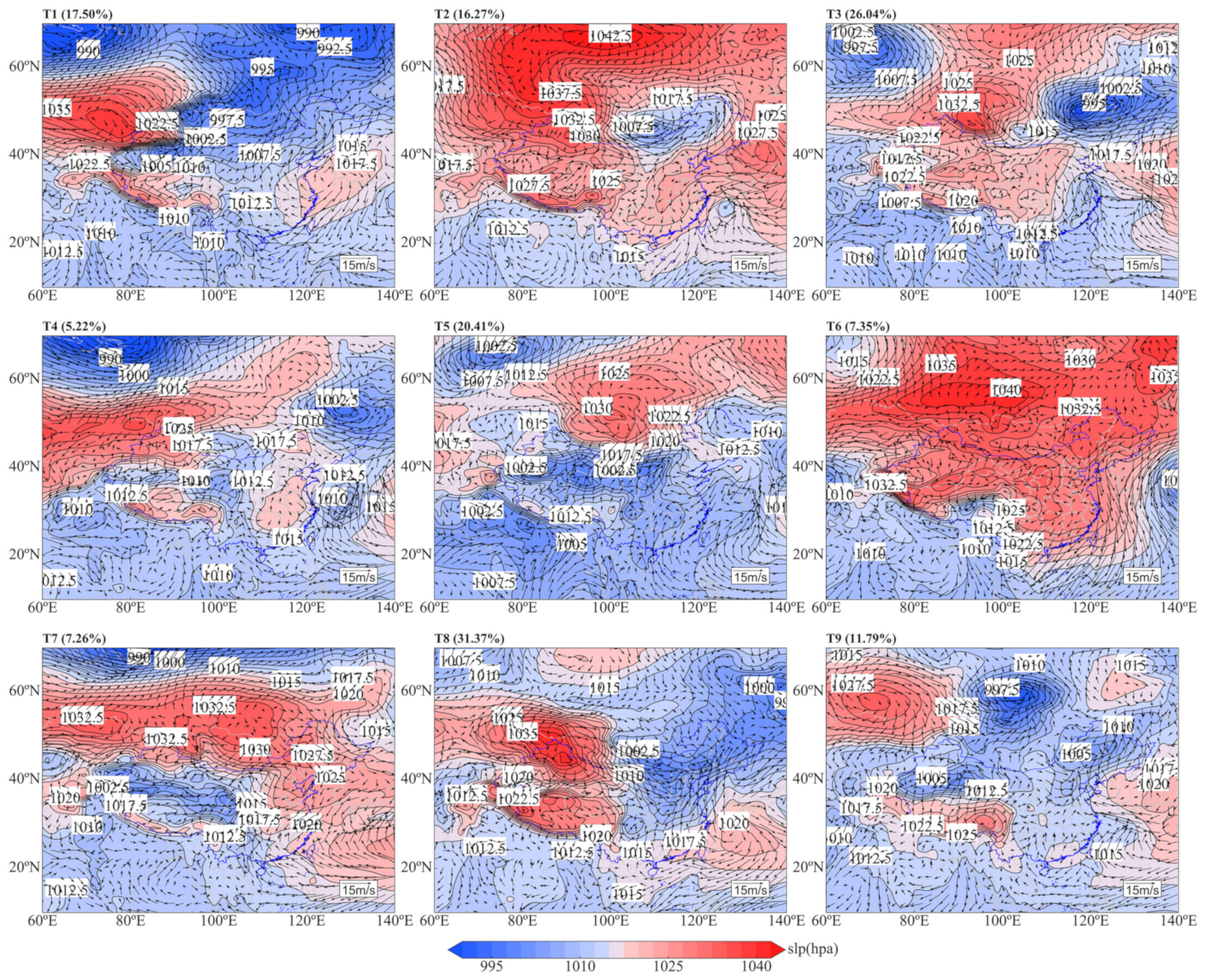

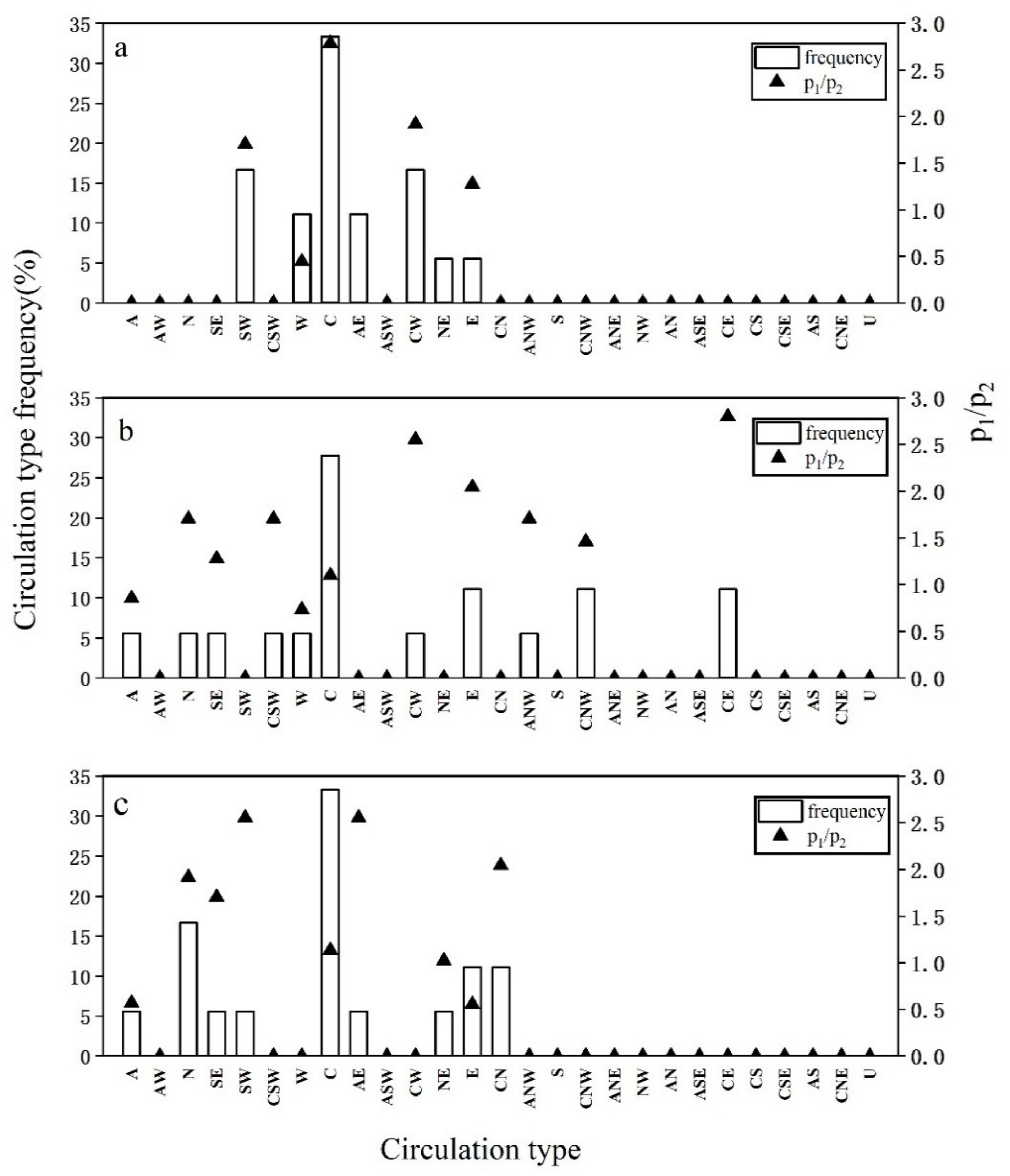

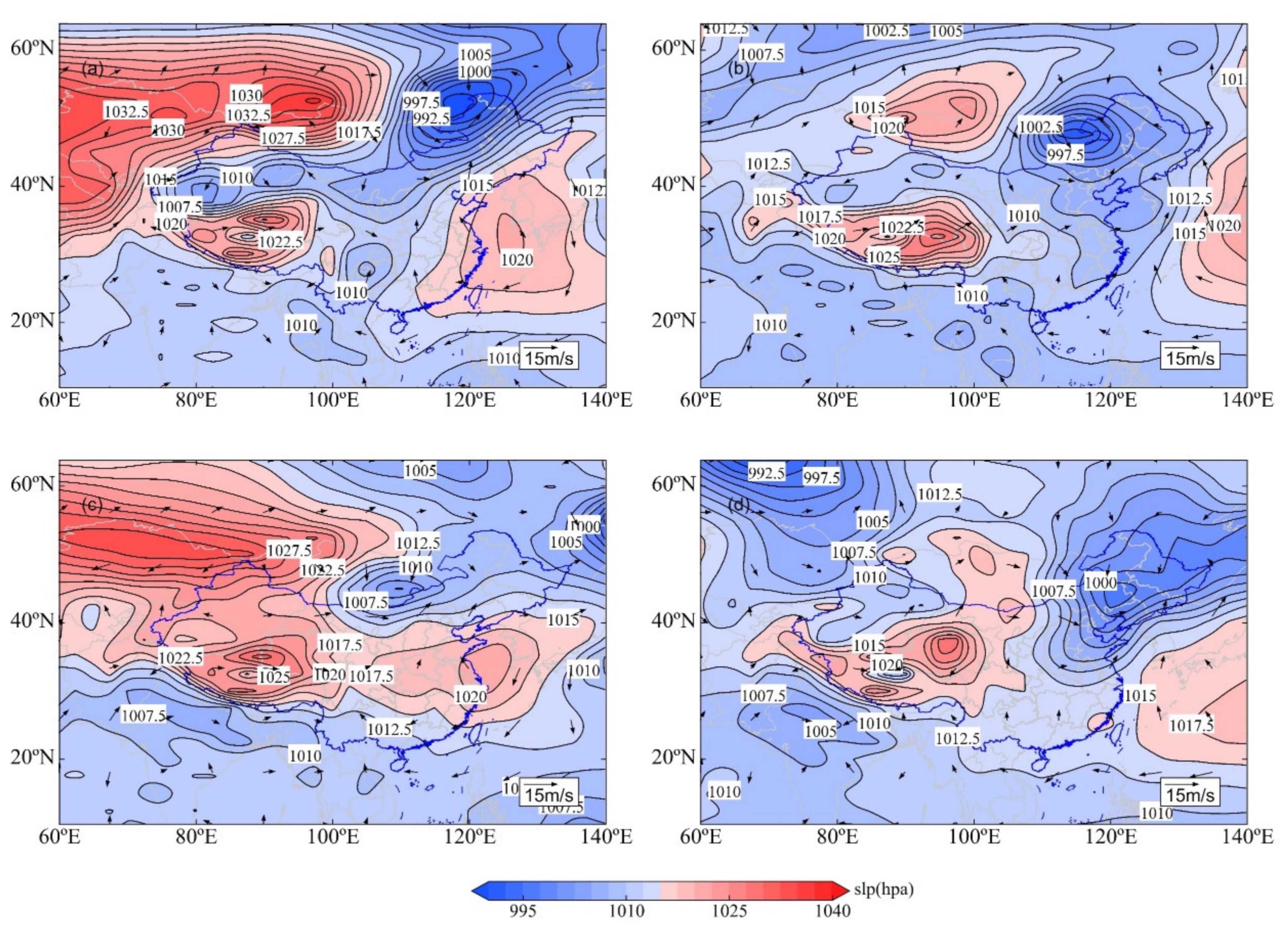
| Floating Dust | Blowing Dust | SDS | Severe SDS | Extreme Severe SDS | |
|---|---|---|---|---|---|
| Wind speed (m/s) | ≤3.0 | >3.0 | >3.0 | >3.0 | >3.0 |
| Visibility (km) | <10 | 1–10 | 0.5–1 | 0.020–0.5 | <0.050 |
(Directional Flow) | (Rotational Flow) | (Mixed Type) | (Undefined) |
|---|---|---|---|
| N(north), NE (northeast), E(east), SE (southeast), S(south), SW (southwest), W(west), NW (northwest) | A(anticyclonic), C(cyclonic) | AN (anticyclonic north), ANE (anticyclonic northeast), AE (anticyclonic east), ASE (anticyclonic southeast), AS (anticyclonic south), ASW (anticyclonic southwest), AW (anticyclonic west), ANW (anticyclonic northwest), CN (cyclonic north), CNE (cyclonic northeast), CE (cyclonic east), CSE (cyclonic southeast), CS (cyclonic south), CSW (cyclonic southwest), CW (cyclonic west), CNW (cyclonic northwest) | UD (undefined) |
Publisher’s Note: MDPI stays neutral with regard to jurisdictional claims in published maps and institutional affiliations. |
© 2021 by the authors. Licensee MDPI, Basel, Switzerland. This article is an open access article distributed under the terms and conditions of the Creative Commons Attribution (CC BY) license (https://creativecommons.org/licenses/by/4.0/).
Share and Cite
Yi, Z.; Wang, Y.; Chen, W.; Guo, B.; Zhang, B.; Che, H.; Zhang, X. Classification of the Circulation Patterns Related to Strong Dust Weather in China Using a Combination of the Lamb–Jenkinson and k-Means Clustering Methods. Atmosphere 2021, 12, 1545. https://doi.org/10.3390/atmos12121545
Yi Z, Wang Y, Chen W, Guo B, Zhang B, Che H, Zhang X. Classification of the Circulation Patterns Related to Strong Dust Weather in China Using a Combination of the Lamb–Jenkinson and k-Means Clustering Methods. Atmosphere. 2021; 12(12):1545. https://doi.org/10.3390/atmos12121545
Chicago/Turabian StyleYi, Ziwei, Yaqiang Wang, Wencong Chen, Bin Guo, Bihui Zhang, Huizheng Che, and Xiaoye Zhang. 2021. "Classification of the Circulation Patterns Related to Strong Dust Weather in China Using a Combination of the Lamb–Jenkinson and k-Means Clustering Methods" Atmosphere 12, no. 12: 1545. https://doi.org/10.3390/atmos12121545
APA StyleYi, Z., Wang, Y., Chen, W., Guo, B., Zhang, B., Che, H., & Zhang, X. (2021). Classification of the Circulation Patterns Related to Strong Dust Weather in China Using a Combination of the Lamb–Jenkinson and k-Means Clustering Methods. Atmosphere, 12(12), 1545. https://doi.org/10.3390/atmos12121545







